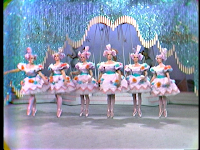 In 1958, the now quite grown-up Shirley Temple began her own television series, Shirley Temple's Storybook. The first season ran through 1958, adapting many stories for children. The series came back in full color in 1960 as The Shirley Temple Show, and for its Christmas episode, Shirley hosted the show with her three children, introducing her own adaptation of Babes in Toyland.
In 1958, the now quite grown-up Shirley Temple began her own television series, Shirley Temple's Storybook. The first season ran through 1958, adapting many stories for children. The series came back in full color in 1960 as The Shirley Temple Show, and for its Christmas episode, Shirley hosted the show with her three children, introducing her own adaptation of Babes in Toyland.The adaptation offers a bit of a surprise to those familiar with the original operetta. It features Alan (Michel Petit) and Jane (Angela Cartwright), two children living with their cruel uncle Barnaby (Jonathan Winters) who wants them out of the way so he can claim their inheritance. He hires Gonzales (Jerry Colonna), Gonzorgo (Carl Ballantine) and Rodrigo (Joe Besser) to take them out to sea on a leaky ship to let them sink. The children survive and are aided by the gypsy Floretta (played by Shirley herself), who proves to be willing to do a dishonest deed for money when she notifies Barnaby as to where the children are.
Alan and Jane escape from the gypsies to the Spider Forest, where spiders abound. Then they find their way to Meantown, where they are imprisoned for being too happy. They break out of jail and find their way to Toyland, where the Master Toymaker (Hanley Stafford) offers to let them stay if he can find something for them to do.
When Barnaby arrives in Toyland, Alan and Jane have disguised themselves as a soldier and a dancing doll and dance and march with the other toys in the "March of the Toys." When Barnaby sees through their disguise, he tells the Toymaker how naughty they've been, but Alan and Jane protest. When the Toymaker says he needs a witness, Floretta enters, offering to witness as revenge on Barnaby who paid her in wooden nickels.
The Toymaker forces Barnaby to give Alan and Jane their money, chiding him for his abominable behavior, quoting "No man stands so tall as when he stoops to help a child." Barnaby, Gonzales, Gonzorgo and Rodrigo are sentenced to live in Meantown. Floretta is allowed to stay in Toyland, where she says she'll help make Voodoo dolls.
Surprisingly, this has been the version that's stuck the closest to the original operetta's plot. It has been quite altered to accommodate the low budget, intended audience and 51-minute runtime: gone are the entire Piper family and any romantic subplots. The Toymaker is a kind, just king rather than a villain, and there is, of course, no business about bringing toys to life for evil purposes.
A number of songs seem to have been invented for this adaptation, making this the first time in a film version that the original Herbert melodies were accompanied by new ones: Alan and Jane sing a ditty about their dolls who are based on characters from the original operetta, Gonzales, Gonzorgo and Rodrigo sing a jingle to introduce themselves, and there is a song sung by the citizens of Meantown about their city. (This may have been not been created for the show as the song "Meantown" appeared on a record adaptation of Toyland, so it may have been originally implemented in a stage version.)
There are still quite a few numbers From the Herbert score remaining: Shirley introduces the story by singing "Toyland," which is then used as an instrumental on the opening titles and the chorus is reprised as a finale. Later, Shirley sings "Floretta" in character and in jail, Alan and Jane sing "Go to Sleep." In Toyland, dancing dolls dance to "In the Toymaker's Shop," and after the Toymaker quotes the first verse of "I Can't Do The Sum," Alan and Jane perform the chorus.
As mentioned above, "The March of the Toys" is a grand number, and in a rare move for Shirley Temple's show, a number of tricks are done to make there appear to be more soldiers than there really are. There is a kaleidoscope effect at first, then a single soldier is shown marching in place between two mirrors (the Rockette effect), then several small versions of the same screen are seen at once, but are sadly badly timed and ruins the illusion that there are hundreds of soldiers doing tricks.
Altogether though, in its low-budget but very well-intentioned way, the production is very enjoyable. It was made available on DVD in 2006 on a disc that included the Shirley Temple episode of Winnie-the-Pooh in a box set of similar discs. It was released for individual sale a couple years later. Now it's available on Hulu.
As for Oz connections, yes, people thought Shirley Temple should have played Dorothy in a film version of Oz, and yes, the first color episode of The Shirley Temple Show was an adaptation of The Land of Oz. But surprise! In the opening title scene, the Jack Pumpkinhead and Soldier costumes from the Oz episode were reused!
















No comments:
Post a Comment